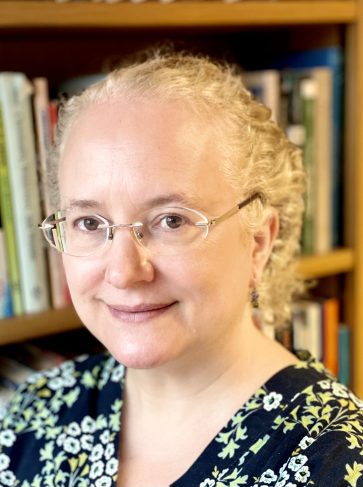Biography
Professor Sarah Perrett is the Associate Director of The Faraday Institute, having joined the Institute in June 2020 as the Course Director. She is also a Visiting Professor at the Institute of Biophysics, Chinese Academy of Sciences, where she has led a research group since 2003 and she continues to divide her time between Beijing and Cambridge. Sarah studied Natural Sciences (Chemistry) at the University of Cambridge and completed a PhD in Protein Chemistry in 1997, supervised by Prof. Sir Alan Fersht FRS. She then held a Research Fellowship at Sidney Sussex College, Cambridge before moving to Beijing in 2000, via a year of full-time Mandarin Chinese language study at the National University of Singapore. She was awarded an OBE for services to UK/China relations in the scientific field in the 2015 Queen’s New Year Honours List. She was elected a Fellow of the Royal Society of Chemistry in 2017. Sarah is the Editor-in-Chief of Essays in Biochemistry (Portland Press). Her research interests include mechanisms of protein folding, amyloid formation and prion propagation. She has published over 100 research articles and has edited three books.
Science and Faith Publications
Scientific Publications (peer-reviewed)
Books
- Perrett S., Buell A.K. & Knowles T.P.J.K. (Editors) Biological and Bio-inspired Nanomaterials, Advances in Experimental Medicine and Biology 1174, 2019, Springer Nature. ISBN: 978-981-13-9790-5.
- Sunde M., Chapman M., Otzen D. & Perrett S. (Editors), Functional Amyloids Biomacromolecules 7, 2017, MDPI. ISSN: 2218-273X.
- Perrett S. (Editor), Amyloids in Health and Disease Essays in Biochemistry 56, 2014, Portland Press. ISBN: 978-185-57-8192-4.
Recent Research Papers (selected from over 100)
- Huang, Y.*, Wen, J., Ramirez, L..M, Gümüşdil, E., Pokhrel, P., Man, V.H., Ye, H., Han, Y., Liu, Y., Li, P., Su, Z., Wang, J., Mao, H., Zweckstetter, M., Perrett, S., Wu, S.*, Gao, M.* (2023). Methylene blue accelerates liquid-to-gel transition of Tau condensates: impacts on functional and pathological roles of Tau. Nature Commun. 14, 5444.
- Zhang, H*., Wu, S., Itzhaki, L.S. & Perrett, S.* (2023). Interaction between huntingtin exon 1 and HEAT repeat structure probed by chimeric model proteins. Protein Sci. 32, e4810.
- Liang, Q., Zhang, Y., Zhang, H., Wu, S., Gong, W. & Perrett S.* (2023). Reversible Redox-Dependent Conformational Switch of the C-Terminal α-Helical Lid of Human Hsp70 Observed by In-Cell NMR. ACS Chem. Biol. 18, 176-183.
- Zhang, H.*, Hu, H., Wu, S. & Perrett S.* (2023). Effect of evolution of the C-terminal region on chaperone activity of Hsp70. Protein Sci. 32, e4549.
- Wu, S.*, Wen, J. & Perrett, S.* (2022). Unravelling the microscopic characteristics of intrinsically disordered proteins upon liquid-liquid phase separation, Essays Biochem. 66, 891-900. (Invited Review, in Thematic Issue on “Shapeshifting Proteins”)
- Yao Q.Q., Wen, J.T., Perrett, S. & Wu, S.* (2022). Distinct lipid membrane-mediated pathways of Tau assembly revealed by single-molecule analysis. Nanoscale 14, 4604-4613.
- Zhang, H.*, Gong, W., Wu, S. & Perrett, S.* (2022). Hsp70 in redox homeostasis. Cells 11, 829.
- Wen, J., Hong, L., Krainer, G., Yao, Q.Q., Knowles, T.P.J., Wu, S.* & Perrett, S.* (2021). Conformational expansion of Tau in condensates promotes irreversible aggregation. J. Am. Chem. Soc. 143, 13056-13064.
- Yang, J., Gong, W., Wu, S., Zhang, H.* & Perrett, S.* (2021). PES inhibits human inducible Hsp70 by covalent targeting of cysteine residues in the substrate binding domain. J. Biol. Chem. 296, 100210.
- Wu, S. Hong, L., Wang, Y., Yang, J., Yang J., Zhang, H. & Perrett, S.* (2020). A kinetic view of the conformational cycle of Hsp70 reveals the importance of the dynamic and heterogeneous nature of Hsp70 for its function. PNAS 117, 7814-7823.
- Yang, J., Dear, A.J., Yao, Q., Liu, Z., Dobson, M., Knowles, T.P.J., Wu, S.* & Perrett, S.* (2020). Amelioration of aggregate cytotoxicity by catalytic conversion of protein oligomers into amyloid fibrils. Nanoscale 12, 18663-18672. (On the inside cover)
- Yang, J., Zhang, H.*, Gong, W., Liu, Z., Wu, H., Hu, W., Chen, X., Wang, L., Wu, S., Chen, C.* & Perrett, S.* (2020). S-Glutathionylation of human inducible Hsp70 reveals a regulatory mechanism involving the C-terminal α-helical lid. J. Biol. Chem. 295, 8302-8324.
- Yao, Q., Hong, L., Wu, S.* & Perrett, S.* (2020). Distinct microscopic mechanisms for the accelerated aggregation of pathogenic Tau mutants revealed by kinetic analysis. PhysChemChemPhys 22, 241-7249.
- Dear, A.J., Michaels, T.C.T., Meisl, G., Klenerman, D., Wu, S., Perrett, S., Linse, S., Dobson, C.M., and Knowles, T.P.J.* (2020) Kinetic diversity of amyloid oligomers. PNAS 117, 12087-12094.
- Yang, J., Dear, A.J., Michaels, T.C.T., Dobson, C.M., Knowles, T.P.J.K.*, Wu, S.* & Perrett, S.* (2018). Direct observation of oligomerization by single molecule fluorescence reveals a multi-step aggregation mechanism for the yeast prion protein Ure2. J. Am. Chem. Soc. 140, 2493-2503.
- Gong, W., Hu, W., Xu, L., Wu, H., Wu, S., Zhang, H., Wang, J., Jones, GW.* & Perrett, S.* (2018). The C-terminal GGAP motif of Hsp70 mediates substrate recognition and stress response in yeast. J. Biol. Chem. 293, 17663-17675.
- Lou, F., Yang, J., Wu, S.* & Perrett, S.* (2017). A co-expression strategy to acheive labeling of individual subunits within a dimeric protein for single molecule analysis. ChemComm 53, 7971-8094.
- Yang, W., Willemse J., Sawyer E.B., Lou F., Gong, W., Zhang, H., Gras, S.L.*, Claessen, D.* & Perrett, S.* (2017). The propensity of the bacterial rodlin protein RdlB to form amyloid fibrils determines its function in Streptomyces coelicolor. Scientific Reports 7, 42867.
- Zhang, H., Yang, J., Si, W., Gong, W., Chen, C.* & Perrett, S.* (2016). Glutathionylation of the bacterial Hsp70 chaperone DnaK provides a link between oxidative stress and the heat shock response. J. Biol. Chem. 291, 6967-6981.
- Zhou, X.M., Shimanovich, U., Herling, T.W., Wu, S., Dobson, C.M., Knowles, T.P.J.* & Perrett, S.* (2015) Enzymatically-active microgels from self-assembling protein nanofibrils for microflow chemistry. ACS Nano 9, 5772-5781.




